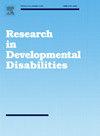Parental stress, quality of life, and behavioral alterations in children with dyslexia
IF 2.6
2区 医学
Q1 EDUCATION, SPECIAL
引用次数: 0
Abstract
Introduction
Dyslexia is a learning disorder that, in addition to affecting reading skills, has a significant impact on emotional, social, and family well-being. Despite advances in understanding the disorder, its influence on parental stress and children's quality of life remains an underexplored area.
Objective
The aim of this study was to analyze differences in parental stress, quality of life, and behavioral profiles between children with dyslexia and those with typical development, as well as to assess possible relationships between these factors.
Method
A total of 100 children (50 diagnosed with dyslexia and 50 with typical development), aged between 8 and 10 years, participated in the study along with their caregivers. Variables were measured using the PSI-SF (parental stress), Kiddo-KINDL (quality of life), and BASC-3 (behavior) instruments, complemented by descriptive statistical analyses, t-tests, and a mediation model.
Results
Caregivers of children with dyslexia exhibited significantly higher levels of stress (p < .001) across all evaluated dimensions, with pronounced effects in the subscales of emotional distress and perceived difficulties in the child. Children with dyslexia showed reduced quality of life, particularly in areas such as self-esteem and social relationships, with statistically significant differences (p < .001). Additionally, they exhibited more behavioral problems, especially in aggression and anxiety. However, mediation analyses did not identify problematic behaviors as direct mediators between dyslexia diagnosis and parental stress.
Conclusions
The findings highlight how dyslexia affects both children and their families, exerting a multidimensional impact. This study underscores the importance of continued research into the interactions between emotional, social, and family factors to optimize support for this population.
阅读障碍儿童的父母压力、生活质量和行为改变
阅读障碍是一种学习障碍,除了影响阅读技能外,对情感、社会和家庭幸福也有重大影响。尽管对这种疾病的了解有所进展,但它对父母压力和儿童生活质量的影响仍然是一个未被充分探索的领域。目的分析阅读障碍儿童与正常发育儿童在父母压力、生活质量和行为特征方面的差异,并评估这些因素之间可能存在的关系。方法100名8 - 10岁的儿童(其中50名患有阅读障碍,50名发育正常)及其照顾者参与了研究。使用PSI-SF(父母压力)、Kiddo-KINDL(生活质量)和BASC-3(行为)工具测量变量,并辅以描述性统计分析、t检验和中介模型。结果阅读障碍儿童的照顾者在所有评估维度上表现出明显更高的压力水平(p <; .001),在儿童的情绪困扰和感知困难的亚量表上有明显的影响。患有阅读障碍的儿童表现出生活质量下降,特别是在自尊和社会关系等方面,差异有统计学意义(p <; .001)。此外,他们表现出更多的行为问题,特别是在攻击性和焦虑方面。然而,中介分析并没有确定问题行为是阅读障碍诊断和父母压力之间的直接中介。结论:研究结果突出了阅读障碍如何影响儿童及其家庭,并产生多方面的影响。这项研究强调了继续研究情感、社会和家庭因素之间相互作用的重要性,以优化对这一人群的支持。
本文章由计算机程序翻译,如有差异,请以英文原文为准。
求助全文
约1分钟内获得全文
求助全文
来源期刊

Research in Developmental Disabilities
Multiple-
CiteScore
5.50
自引率
6.50%
发文量
178
期刊介绍:
Research In Developmental Disabilities is aimed at publishing original research of an interdisciplinary nature that has a direct bearing on the remediation of problems associated with developmental disabilities. Manuscripts will be solicited throughout the world. Articles will be primarily empirical studies, although an occasional position paper or review will be accepted. The aim of the journal will be to publish articles on all aspects of research with the developmentally disabled, with any methodologically sound approach being acceptable.
 求助内容:
求助内容: 应助结果提醒方式:
应助结果提醒方式:


